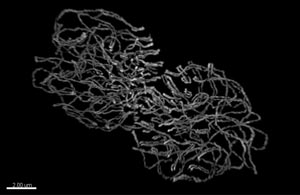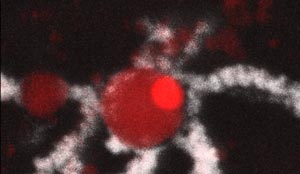-

Superresolution imaging of meiotic chromosomes in lizard oocytes.
Chromosome Biology
Our lab studies various aspects of chromosome biology ranging from the maintenance of chromosome ends by telomerase to the effects of hybridization, ploidy changes and unisexual reproduction in the context of evolution.
-

T-sphere (red) at the end of chomosomes (white)
Telomeres
Telomeres cap the ends of chromosomes, distinguish them from DNA breaks and provide a buffer that enables cells to compensate for the inability of DNA polymerases to fully replicate a linear molecule (also known as the end replication problem). We are interested in the molecular mechanism of telomere length regulation and end protection. In light of many studies correlating telomere length with various disease risks, we believe that a thorough understanding of the physiological consequences of telomere length changes is warranted.
Recent Publications:
"Minishelterins separate telomere length regulation and end protection in fission yeast." -

T-sphere (red) at the end of chomosomes (white)
Telomerase
Using part of a non-coding RNA as template, telomerase replenishes telomeres to permit continued proliferation of cells. Given the key role this enzyme plays in several degenerative diseases and cancer, it is pivotal that we gain a better understanding of how the enzyme is made, recruited to chromosome ends and regulated in its activity. A thorough understanding of these fundamental biological processes will form the foundation for the development of drugs that can stimulate telomerase in patients with insufficient telomerase activity or inhibit the enzyme in the context of cancer treatment.
Recent Publications:
"Human Telomerase RNA Processing and Quality Control."
"Pof8 is a La-related protein and a constitutive component of telomerase in fission yeast." -

Follicle
Meiosis & Reproduction
While reproduction in most vertebrate species involves the fusion of male and female gametes, some fascinating exceptions exist such as all-female species of whiptail lizards. We are interested in the cellular and molecular mechanisms that trigger a switch to parthenogenesis (virgin birth) and permit females of some species to reproduce clonally. In addition to providing new insights into the evolution of reproduction, we are developing a clonal vertebrate model to study development, regulation of gene expression and various aspects of chromosome biology.
Recent Publications:
"Widespread failure to complete meiosis does not impair fecundity in parthenogenetic whiptail lizards" -

Parthenogenetic lizard, Aspidoscelis neavesi
Hybridization & Ploidy
Interspecific hybridization is the basis for ‘hybrid vigor’, and ploidy increases expand the genetic repertoire that permits adaptation to a changing environment. But combining two or more distinct genomes in each cell of a complex organism can also result in incompatibilities. Using lizards of the genus Aspidoscelis we are examining the immediate and long-term consequences of hybridization and ploidy changes.
Recent Publications:
"Neaves' Whiptail Lizard: the first known tetraploid parthenogenetic tetrapod (Reptilia: Squamata: Teiidae)."


